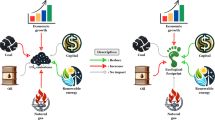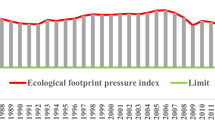Abstract
The need to reduce the emissions of greenhouse gases in energy generation has led to international and national bodies recommending and encouraging a series of policies and measures to boost so-called green energy generation and achieve sustainability in the energy sector. In order to assess the energy sustainability path of countries worldwide, we first propose a dynamic analysis of an energy sustainability index (ESI) based on the methodology of composite indicators built on a large dataset of 136 heterogeneous countries and 38 variables observed in 3 years (2000, 2005 and 2011). Second, to isolate the influence of socio-demographic and economic characteristics on the energy sustainability of countries, we perform quantile regression with clustered data. Our findings demonstrate that major changes are required in developing countries, where development is pursued mainly through the use of energy sources based on fossil fuels. To ensure access to sustainable energy, policy makers need to consider and improve the key factors according to the ESI’s quantiles. In particular, human development variables (i.e., life expectancy and the percentage of completed secondary schooling attained in the population) and the variables related to civil rights and institutions (e.g., percentage of women in national parliaments) are crucial in promoting energy sustainability. By contrast, high unemployment rates, high congestion costs and the continued use of highly polluting energy sources have the effect of reducing energy sustainability.


Similar content being viewed by others
Notes
Exergy is a thermodynamic property that links the first and second principles of thermodynamics, besides connecting a system under study with the environment where it belongs.
PCA is usually employed in an explanatory data analysis framework as well as for developing predictive models and a wide range of applications concerned with both economic, social and environmental aspects.
Variance inflation factors (VIF) measure how much the variance of the estimated regression coefficients are inflated as compared to when the predictor variables are not linearly related. It describes how much multicollinearity (correlation between predictors) exists in a regression analysis. Multicollinearity is problematic because it can increase the variance of the regression coefficients, making them unstable and difficult to interpret. We use the following guidelines to interpret the VIF: VIF = 1, Not correlated; 1 < VIF < 5, Moderately correlated; VIF > 5–10, Highly correlated.
HDI is a development indicator developed by the Pakistani economist Mahbubul Haq, based on the ideas of Amartya Sen. It has been used alongside GDP by the United Nations since 1993 to assess the quality of life in member countries. The HDI takes account of three elements in particular: the level of health, educational level, and per capita GDP.
References
Agovino, M., Garofalo, A., Mariani, A.: Effects of environmental regulation on separate waste collection dynamics: empirical evidence from Italy. J. Clean. Prod. (2016). https://doi.org/10.1016/j.jclepro.2016.02.082
Bhattacharyya, S.C.: Energy access programmes and sustainable development: a critical review and analysis. Energy Sustain. Dev. 16(3), 260–271 (2012)
Buchinsky, M.: Recent advances in quantile regression model: a practical guideline for empirical research. J. Hum. Resour. 33, 88–126 (1998)
Caragliu, A., Del Bo, C., Nijkamp, P.: Smart cities in Europe. J. Urb. Technol. 18, 65–82 (2011). https://doi.org/10.1080/10630732.2011.601117
Chamberlain, G.: Quantile regression, censoring and the structure of wages. In: Sims, C.A. (ed.) Advances in Econometrics, pp. 171–209. CUP, Cambridge (1994)
Chaurey, A., Krithika, P., Palit, D., Rakesh, S., Sovacool, B.K.: New partnerships and business models for facilitating energy access. Energy Policy 47, 48–55 (2012)
Chung, S.: Environmental regulation and foreign direct investment: evidence from South Korea. J. Dev. Econ. 108, 222–236 (2014)
Combes, P.P.: Economic structure and local growth: France, 1984–1993. J. Urb. Econ. 47, 329–355 (2000)
Desjardins, S., Gomes, R., Pursnani, P., West, C.: Accelerating access to energy: lessons learned from efforts to build inclusive energy markets in developing countries. http://www.Shellfoundation.org/ShellFoundation.org_new/media/Shell-Foundation-Reports/Access_to_Energy_Report_2014.pdf (2014). Accessed 14 Jan 2016
Dimakis, A.A., Arampatzis, G., Assimacopoulos, D.: Monitoring the sustainability of the Greek energy system. Energy Sustain. Dev. 16, 51–56 (2012)
Doukas, H., Papadopoulou, A., Savvakis, N., Tsoutsos, T., Psarras, J.: Assessing energy sustainability of rural communities using Principal Component Analysis. Renew. Sustain. Energy Rev. 16, 1949–1957 (2012)
DTI: UK energy sector indicators 2006. Department of Trade and Industry, DTI/Pub 8252, URN 06/193 (2006)
EEA: EEA core set of indicators. European environment agency technical report no 1/2005; 2005. ISSN 1725-2237 (2005)
Garcia-Alvarez, M.T., Moreno, B., Soares, I.: Analyzing the sustainable energy development in the EU-15 by an aggregate synthetic index. Ecol. Ind. 60, 996–1007 (2016)
Hacatoglu, K., Dincer, I., Rosen, M.A.: A new model to assess the environmental impact and sustainability of energy systems. J. Clean. Prod. 103, 211–218 (2015)
Hak, T., Moldan, B., Dahl, A.L.: Sustainability indicator: a scientific assessment. Island Press, Washington (2007)
Hardi, P., Barg, T.: Measuring sustainable development: review of current practice. Occasional Paper No. 17, Industry Canada (1997)
Hudrilikova, L.: Composite indicators as a useful tool for international comparison: the Europe 2020 example. Prague Econ. Pap. 4, 459–473 (2013)
IAEA, UNDESA, IEA, EUROSTAT, EEA: Energy indicators for sustainable development: guidelines and methodologies. IAEA Publishing Section, Vienna (2005)
IAEA, UNDESA: Energy indicators for sustainable development: country studies on Brazil, Cuba, Lithuania, Mexico, Russian Federation, Slovakia and Thailand. IAEA Publishing Section, Vienna (2015)
Kim, T.H., White, H.: Estimation, inference, and specification testing for possibly misspecified quantile regressions. In: Fomby, T., Hill, R.C. (eds.) Maximum likelihood estimation of misspecified models: twenty years later, pp. 107–132. Elsevier, New York (2003)
Kneller, R., Pisu, M.: Industrial linkages and export spillovers from FDI. World Econ. 30, 105–134 (2007)
Koenker, R., Bassett Jr., G.S.: Regression quantiles. Econometrica 46, 33–50 (1978)
Kruckenberg, L.J.: North–South partnerships for sustainable energy: knowledge–power relations in development assistance for renewable energy. Energy Sustain. Dev. 29, 91–99 (2015)
Liu, G.: Development of a general sustainability indicator for renewable energy systems: a review. Renew. Sustain. Energy Rev. 31, 611–621 (2014)
Magnus Blomström, R.L., Zejan, M.: Is fixed investment the key to economic growth? Q. J. Econ. 111, 269–276 (1996)
Martín-Gamboa, M., Iribarren, D., García-Gusano, D., Dufour, J.: A review of life-cycle approaches coupled with data envelopment analysis within multi-criteria decision analysis for sustainability assessment of energy systems. J. Clean. Prod. 150, 164–174 (2017). https://doi.org/10.1016/j.jclepro.2017.03.017
Mulugetta, Y.: Human capacity and institutional development towards a sustainable energy future in Ethiopia. Renew. Sustain. Energy Rev. 12, 1435–1450 (2008)
Nardo, M., Saisana, M., Saltelli, A., Tarantola, S.: Tools for composite indicators building. ISPRA: Joint Reseach Center. EUR 21682 (2005)
Narula, R., Dunning, J.H.: Industrial development, globalization and multinational enterprises: new realities for developing countries. Oxf. Dev. Stud. 28(2), 141–167 (2000)
Neves, A.R., Leal, V.: Energy sustainability indicators for local energy planning: review of current practices and derivation of a new framework. Renew. Sustain. Energy Rev. 14, 2723–2735 (2010)
Nussbaum, M.: Human capabilities, female human beings. In: Nussbaum, M., Glover, J. (eds.) Women, Culture and Development. Clarendon Press, Wotton-under-Edge (1995)
Nussbaum, M.: Women and human development: the capabilities approach. Cambridge University Press, Cambridge (2000)
OECD: Handbook on Constructing Composite Indicators. Methodology and User Guide. OECD, Paris (2008)
Ordouei, M.H., Elsholkami, M., Elkamel, A., Croiset, E.: New composite sustainability indices for the assessment of a chemical process in the conceptual design stage: case study on hydrogenation plant. J. Clean. Prod. (2016). https://doi.org/10.1016/j.jclepro.2016.02.107
Parente, P.M., Santos Silva, J.: Quantile regression with clustered data. J. Econom. Methods 5(1), 1–15 (2016). https://doi.org/10.1515/jem-2014-0011
Pazienza, P., De Lucia, C., Vecchione, V., Palma, E.: Foreign direct investments, environmental sustainability, and strategic planning: a local perspective. Chin. Bus. Rev. 10, 29–40 (2011)
Petinrin, J.O., Shaaban, M.: Renewable energy for continuous energy sustainability in Malaysia. Renew. Sustain. Energy Rev. 50, 967–981 (2015)
Phillis, Y.A., Kouikoglou, V.S., Manousiouthakis, V.: A review of sustainability assessment models as system of systems. IEEE Syst. J. 4, 15–25 (2010)
Rausch, S., Mowersc, M.: Distributional and efficiency impacts of clean and renewable energy standards for electricity. Resour. Energy Econ. 36, 556–585 (2014)
Recalde, M.Y., Guzowski, C., Zilio, M.I.: Are modern economies following a sustainable energy consumption path? Energy. Sustain. Dev. 19, 151–161 (2014)
Romano, A.A., Scandurra, G., Carfora, A.: Probabilities to adopt feed in tariff conditioned to economic transition: a scenario analysis. Renew. Energy 83, 988–997 (2015)
Romero, J.C., Linares, P.: Exergy as a global energy sustainability indicator. A review of the state of the art. Renew. Sustain. Energy Rev. 33, 427–442 (2014)
Santoyo-Castelazo, E., Azapagic, A.: Sustainability assessment of energy systems: integrating environmental, economic and social aspects. J. Clean. Prod. 80, 119–138 (2014)
Sardain, A., Tang, C., Potvin, C.: Towards a dashboard of sustainability indicators for Panama: a participatory approach. Ecol. Ind. 70, 545–556 (2016)
Sen, A.K.: Well being, capability, and public policy. Giornale degli Economisti e Annali di Economia LIII, 7–9 (1994)
Sen, A.K.: Development as Freedom. Oxford University Press, Oxford (1999)
Sen, A.K.: Razionalità e libertà. Il Mulino, Bologna (2002)
Sen, A.K.: Capabilities, lists, and public reason: continuing the conversation. Fem. Econ. 10, 77–80 (2004)
Sen, A.K.: What do we want from a theory of justice? J. Philos. CIII, 215–238 (2006)
Sen, A.K.: The idea of justice. J. Hum. Dev. 9, 331–342 (2008)
Sen, A.K.: Capability: reach and limits. In: Chiappero-Martinetti, E. (ed.) Debating Global Society: Reach and Limits of the Capability Approach. Fondazione Giacomo Feltrinelli, Milan (2009)
Singh, R.K., Murty, H.R., Gupta, S.K., Dikshit, A.K.: An overview of sustainability assessment methodologies. Ecol. Ind. 9, 189–212 (2009)
Sovacool, B.K., Drupady, I.M.: Examining the small renewable energy power (SREP) program in Malaysia. Energy Policy 39, 7244–7256 (2011)
Tamazian, A., Chousa, J.P., Vadlamannati, K.C.: Does higher economic and financial development lead to environmental degradation: evidence from BRIC countries. Energy Policy 37, 246–253 (2009)
Toklu, E., Guney, M.S., Isik, M., et al.: Energy production, consumption, policies and recent developments in Turkey. Renew. Sustain. Energy Rev. 1, 1172–1186 (2010)
Tsai, W.T.: Energy sustainability from analysis of sustainable development indicators: a case study in Taiwan. Renew. Sustain. Energy Rev. 14, 2131–2138 (2010)
UNDESA: Indicators of Sustainable Development, 2nd edn. United Nations Department of Economic and Social Affairs, New York (2001)
Vera, I., Langlois, L.: Energy indicators for sustainable development. Energy 32, 875–882 (2007)
Warhurst, A.: Sustainability Indicators and Sustainability Performance Management. Report to the project: Mining, Minerals and Sustainable Development (MMSD). International Institute for Environment and Development (IIED), Warwick (2002)
WCED: Our Common Future (The Brundtland Report). Oxford University Press, Oxford (1987)
Zeng, K., Eastin, J.: Do developing countries invest up? The environmental effects of foreign direct investment from less-developed countries. World Dev. 40, 2221–2233 (2012)
Zhao, X.S., Chan, R.C.K., Chan, N.Y.M.: Spatial polarization and dynamic pathways of Foreign Direct Investment in China 1990–2009. Geoforum 43, 836–850 (2012)
Author information
Authors and Affiliations
Corresponding author
Rights and permissions
About this article
Cite this article
Agovino, M., Garofalo, A., Romano, A.A. et al. Explanatory analysis of the key factors in an energy sustainability index. Qual Quant 52, 2597–2632 (2018). https://doi.org/10.1007/s11135-017-0679-0
Published:
Issue Date:
DOI: https://doi.org/10.1007/s11135-017-0679-0




